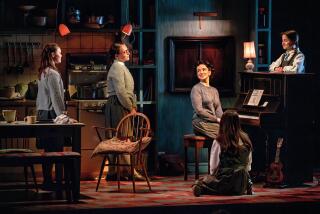The Desert’s Doyenne of Dance
DEATH VALLEY JUNCTION, Calif. — At this lonely desert crossroads, wild mustangs graze, dust devils spin and a spectacular opera house awaits the evening’s sold-out performance.
The walls of the theater glow with an elaborate mural of 16th century Spanish royalty and commoners, painted by a ballerina who once upon a time danced only for their gaze. Now more than 100 people come to each of her shows, although the nearest restaurant is in a state-line casino seven miles away and the nearest town is 20 miles farther.
To Marta Becket, this improbable place is a destiny predicted by a fortuneteller more than 30 years ago. Becket is a woman who believes in fortunetellers and destiny and many other things that some may deem unlikely. Maybe that’s why, at 75, she puts on toe shoes and dances on a stage she created in one of the emptiest stretches of the Mojave Desert.
How Becket and the opera house came to this corner of nowhere is by now California lore.
Becket was a New York dancer and painter on break from tour when her trailer got a flat tire nearby in 1967. While her then-husband got the tire fixed, Becket discovered an abandoned hotel and social hall built by Pacific Coast Borax Co. when mining was booming in the 1920s. Peering through a hole in the back door of the hall, she saw a stage.
“My life split in two at this junction,” she said. “I looked at the stage and knew it was my future. I knew I’d perform here for the rest of my life.”
The next day, Becket and husband Tom Williams leased the buildings. She discovered that before 1907, the town had been called Amargosa, the Spanish word for bitter. She named the crumbling adobe theater the Amargosa Opera House and began restoring the adjacent 14-room hotel.
Becket never looked back.
“Out here I had a great feeling of optimism that you don’t get in New York,” she said. “Anything seemed possible.”
She still likes to recount how, after she named the opera house Amargosa, she remembered that before she left the East Coast a fortuneteller predicted that she would move to a far-off, rural place, that the letter A would predominate and that she would do the most satisfying work of her life.
But these days, Becket is having a premonition of her own. She has painted her vision on a wall in the hotel lobby. In the picture, the low-slung hotel and the theater are deserted. They are being swallowed by the gold of the surrounding desert that swirls in sandstorms in the foreground.
The only presence is a filmy white ballerina floating above, just a speck against the emptiness.
On this November Saturday night, the curtain rises at exactly 8:15, just as it did in the early years when Becket danced even if no one came.
The 120-seat theater is packed, with, among others, a Milwaukee couple who remembered seeing Becket on the “Ripley’s Believe It or Not” TV show 15 years ago and made a detour from Las Vegas 100 miles away. There’s also a young German woman who worked on a French documentary about Becket a decade ago.
The music is by Strauss. Over the years, Becket has chased away anyone who proposed a future for the opera house that would introduce music other than classical or the occasional honky-tonk for theatrical purposes.
On stage there is a warble to her voice. She is thin, but her expressions are as varied and fluid as shifting sand dunes. To say that Becket was beautiful when she was young, as evidenced by photographs in her program, is to do a disservice to the beauty she still holds.
She is flexible, striking classic ballet poses. When the spotlight casts her shadow behind her there are two images: Becket, the weathered skin on her back showing her years, and her dancing silhouette, which could be that of a teenager.
She can no longer perform some feats once in her repertoire. “When I was 57 I was rehearsing and I broke down because I couldn’t do fouettes. I fell down on the stage and wept,” she said. “Now, at this stage, I have a philosophy that I have to look at it as a challenge to find another way. It’s like water running down a roof: If one way is blocked, it finds another.”
She creates two shows a year for her season, from October to May. In this production, “The Good Time Cabaret,” she is by turns a flirty waitress, a conniving huckster, a betrayed lover, a cancan dancer and a mustachioed ladies’ man. Her comic foil is Tom Willett, a Wilford Brimley look-alike who stepped in as both beau and stage manager after her husband left in 1982. She made Willett her co-star when she saw him dancing with a broom. The former mailman is a crowd pleaser, wielding a rolling pin and wearing a voluminous nightgown.
“He is a natural comedic presence,” Becket said.
The vignettes of the program interweave until the last loose ends are tied into a bow in the final seconds.
Would a critic pronounce it worthy? Who knows? When Becket came to Death Valley, she no longer needed to base the value of her work on the opinion of others.
“I love theater. I love dance,” she said. “When I found this place, I was preserving the life I wanted to live. If no one came, I would still have my work. The joy is in the effort.”
Screenwriter Todd Robinson, who directed a documentary film about Becket that he hopes will premiere at the Sundance film festival in January, recalls the first time he saw her show.
“While I sat there I was overwhelmed with the feeling that I wasn’t in the audience watching a performance on a proscenium stage; I was inside looking at her perception of the world. It knocked me out,” he said. “To me, she made Amargosa more than a place. It’s a state of mind about pure creative spirit.”
Offstage, Becket is still theatrical. She wears her hair long and jet black. Her expressive cat eyes are accented with black eyeliner.
The day after the performance, when most guests have left, Becket walks a visitor through her art gallery, which is painted on the walls.
The opera house is adorned with a king, a queen, courtesans, bullfighters, priests and Gypsies. The theater’s ceiling is a deep blue, Renaissance-like creation with billowing clouds, cherubs and a central dome depicting 16 women playing antique instruments.
The hotel displays her trompe l’oeil paintings of archways and winding staircases bidding the viewer to enter. Recently, Becket began painting whimsical environments in each room.
When she arrives at one of her latest works--”Jezebel’s Suite,” complete with painted feather boas and boudoir slippers--the key won’t turn in the door. She shakes her head.
“You do know this hotel is haunted?” she says. “We’re not supposed to go in there right now.”
Even someone not given to blaming jammed doors on ghostly presences can feel that Death Valley Junction is haunted by another time. Pieces of railroad ties are still scattered about from when this was a bustling railroad junction with a population of 300.
Becket says her opera house is dedicated to forgotten theaters that never got a second life. “The walls of this theater and I dedicate these murals to the past, without which our times would have no beauty,” reads a Latin scroll in the theater.
Becket may soon receive help in keeping her opera house alive. Save America’s Treasures, a partnership between the White House Millennium Council and the National Trust for Historical Preservation, this month designated the Amargosa Opera House as one of its projects.
The designation casts a welcome spotlight on the opera house, where Becket and Willett scramble to bring in enough money to maintain the buildings and repair the leaky roof. They charge $10 a head at performances, hawk glossy pamphlets and raise money with a donation jar to save wild burros at the nearby national park.
Despite the fans who have made their way to Amargosa over the years, it remains a place apart.
Becket would have it no other way. She bristles when Willett suggests that if she had it to do over she might want to try a more conventional life without artistic obsession.
“How completely boring!” she said. “I would never want to be ordinary.”
More to Read
The biggest entertainment stories
Get our big stories about Hollywood, film, television, music, arts, culture and more right in your inbox as soon as they publish.
You may occasionally receive promotional content from the Los Angeles Times.











